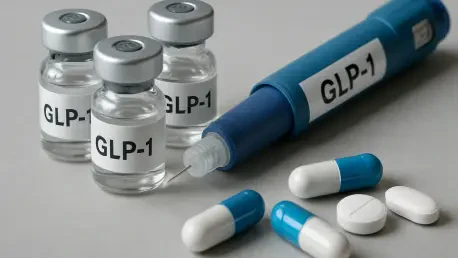In a striking move that has sent ripples through the healthcare and telehealth sectors, the U.S. Food and Drug Administration (FDA) has initiated a robust crackdown on the compounding of GLP-1 drugs like semaglutide and tirzepatide, medications that have skyrocketed in popularity for weight loss. Amid shortages of branded versions, telehealth companies, compounding pharmacies, and other providers have rushed to meet soaring demand, often through questionable marketing practices. The FDA’s response—over 100 warning letters targeting misleading claims—underscores a critical tension between patient safety and the rapid expansion of digital health solutions. This regulatory action not only highlights potential risks associated with compounded drugs but also raises broader questions about ethical responsibility in an era where telehealth is transforming access to care. As the landscape evolves, understanding the driving forces behind this enforcement effort becomes essential for stakeholders navigating the intersection of innovation and regulation.
Regulatory Actions and Concerns
FDA’s Stance on Misleading Claims
The FDA has taken a firm stand against the deceptive promotion of compounded GLP-1 drugs, issuing over 100 warning letters to entities falsely advertising these medications as FDA-approved or equivalent to branded options such as Ozempic or Mounjaro. Unlike their branded counterparts, compounded drugs bypass the stringent safety, efficacy, and quality testing mandated by the FDA, leaving room for significant variability in their composition. This lack of oversight can result in formulations that fail to meet consistent standards, posing unknown risks to consumers. The agency’s primary grievance lies in marketing that creates a false sense of security among patients, many of whom are unaware that these products have not undergone the rigorous vetting process required for approval. Such misrepresentation not only undermines public trust in healthcare but also jeopardizes patient well-being by obscuring critical distinctions between regulated and unregulated medications.
Beyond the immediate issue of false advertising, the FDA’s actions signal a broader intent to tighten control over the compounding industry, particularly in high-demand areas like weight-loss therapies. Compounded GLP-1 drugs often rely on ingredients sourced from unverified suppliers, and manufacturing practices can vary widely, leading to potential inconsistencies in dosage or purity. The agency’s enforcement efforts aim to curb the proliferation of unsubstantiated claims that these drugs are risk-free or interchangeable with FDA-approved versions. By targeting these misleading narratives, the FDA seeks to reassert the importance of transparency in healthcare marketing, ensuring that patients receive accurate information about the products they use. This crackdown serves as a reminder that regulatory oversight remains a cornerstone of patient protection, especially in markets driven by intense consumer demand and rapid innovation.
Telehealth as a Primary Target
Telehealth companies have emerged as central figures in the GLP-1 compounding surge, leveraging digital platforms to market these drugs directly to consumers on a massive scale, which has made them a primary focus of the FDA’s enforcement actions. Over half of the warning letters issued by the agency have been directed at these entities, reflecting their outsized role in promoting compounded medications through aggressive online advertising. The scalability of telehealth models allows providers to reach vast audiences quickly, often prioritizing accessibility over thorough risk communication. This approach, while innovative, has drawn scrutiny for potentially downplaying the uncertainties associated with non-FDA-approved drugs, leaving patients vulnerable to incomplete or misleading information about the therapies they pursue.
The issue extends beyond telehealth to other healthcare sectors, including concierge practices and medical spas, which have also embraced the GLP-1 compounding trend as a lucrative opportunity amid branded drug shortages. These providers often market weight-loss solutions as part of premium or aesthetic services, further blurring the lines between medical necessity and commercial interest. The widespread involvement of diverse healthcare models illustrates the pervasive nature of the problem, prompting the FDA to cast a wide net in its regulatory response. As telehealth and related sectors continue to grow, the agency’s focus on these providers underscores a critical public health concern: the need to balance the benefits of expanded access with the imperative to safeguard patients from unverified treatments and unchecked marketing tactics.
Patient Safety and Ethical Implications
Risks to Patients
GLP-1 therapies, while effective for weight loss, carry known side effects such as nausea, pancreatitis, and, in rare cases, thyroid tumors, risks that become even more pronounced when dealing with compounded versions lacking FDA oversight. These non-standardized formulations may differ in potency or composition due to inconsistent manufacturing practices or questionable ingredient sourcing, amplifying the potential for adverse reactions. Patients, driven by the promise of quick results and often influenced by persuasive online ads, may not fully appreciate the uncertainties involved. The FDA has emphasized that without clear disclosure of these risks, individuals are left making health decisions based on incomplete or overly optimistic information, a situation that can lead to serious consequences for their well-being.
In telehealth settings, where direct patient-provider interaction is often limited to virtual consultations, ensuring informed consent becomes a significant challenge. The absence of face-to-face discussions can hinder the ability to convey nuanced information about the potential dangers of compounded GLP-1 drugs, leaving room for misunderstandings. Patients might assume that telehealth-prescribed medications carry the same assurances as those obtained through traditional channels, a misconception that can exacerbate safety concerns. Experts and regulators alike stress the importance of robust communication strategies to bridge this gap, urging providers to prioritize detailed risk-benefit discussions even in digital formats. Only through such transparency can patients make truly informed choices about their treatment paths.
Clinician Responsibilities
Healthcare providers face a pressing ethical obligation to place patient trust and safety above commercial incentives, particularly when prescribing or promoting compounded GLP-1 drugs in telehealth or other settings. This means offering accurate, balanced information about the limitations and risks of these medications, avoiding any implication that they match the reliability of FDA-approved alternatives. Clinicians must take extra care to document informed consent, ensuring that patients understand the potential uncertainties involved. By fostering open dialogue, providers can help maintain credibility in a field increasingly scrutinized for prioritizing profit over patient welfare, thereby reinforcing the integrity of medical practice amid evolving regulatory expectations.
Failure to adequately communicate risks carries significant consequences, extending beyond patient harm to potential legal and professional repercussions for clinicians. Misleading marketing or insufficient disclosure can expose providers to malpractice claims or disciplinary actions from medical boards, especially if patients suffer adverse outcomes from compounded drugs. The FDA’s crackdown serves as a stark warning that ethical lapses will not be tolerated, pushing clinicians to reevaluate their practices in light of heightened oversight. As telehealth continues to reshape healthcare delivery, the responsibility to uphold transparency becomes paramount, ensuring that patient care remains grounded in trust and accountability rather than commercial expediency.
Broader Regulatory and Market Trends
Federal Scrutiny of Digital Health
The FDA’s crackdown on GLP-1 compounding is not an isolated effort but part of a larger federal push to address deceptive health advertising in the digital realm, involving agencies like the Department of Health and Human Services (HHS) and the Federal Trade Commission (FTC). These coordinated actions target misleading claims across online platforms, where telehealth providers often promote compounded drugs without adequate risk disclosures. The surge in digital health marketing has amplified the potential for consumer deception, prompting regulators to intensify oversight of virtual healthcare models. This broader scrutiny reflects a growing recognition that the rapid expansion of telehealth, while beneficial for access, requires strict guardrails to prevent exploitation and protect public health.
For telehealth providers and compounding entities, the implications of this federal focus are profound, encompassing legal, reputational, and financial risks. Non-compliance with regulatory standards can lead to penalties, lawsuits, or loss of consumer trust, all of which threaten business viability in a competitive market. The FTC’s parallel efforts to pursue deceptive advertising cases further heighten the stakes, signaling that enforcement will remain rigorous across multiple fronts. As digital health continues to evolve, providers must adapt to a landscape of increasing accountability, aligning their practices with federal guidelines to mitigate the fallout from intensified regulatory attention and maintain their standing in the industry.
Market Dynamics and Competition
Shortages of branded GLP-1 drugs like semaglutide and tirzepatide have created fertile ground for compounding pharmacies and telehealth companies to step in, turning a supply gap into a commercial boom with widespread marketing of customized alternatives. This surge capitalized on patient desperation for weight-loss solutions, with providers using direct-to-consumer models to offer accessible, albeit unregulated, options. The rapid proliferation of these compounded drugs highlights how market demand can outpace regulatory frameworks, creating a gray area where innovation and risk collide. While this trend has expanded treatment availability, it has also raised alarms about the quality and safety of products flooding the market without sufficient oversight.
The competitive landscape has shifted dramatically as a result, with traditional weight-loss models like WeightWatchers facing decline under pressure from telehealth-driven alternatives that promise faster, more convenient solutions. This market disruption illustrates the high stakes for both established players and new entrants, as telehealth’s rise reshapes consumer expectations and business strategies. However, the financial success of these newer models comes with vulnerabilities, as regulatory crackdowns and public scrutiny could undermine their growth if trust erodes. The interplay between market forces and federal enforcement underscores a critical challenge: sustaining innovation in healthcare delivery while ensuring that patient safety remains the guiding principle amid fierce competition.
Reflecting on a Path Forward
Looking back, the FDA’s decisive crackdown on GLP-1 compounding addressed a pivotal moment for telehealth and healthcare providers, spotlighting the dangers of misleading marketing and the urgent need for patient safety. The wave of warning letters, targeting over 100 entities, tackled false claims that jeopardized public trust and health. As federal agencies like HHS and FTC joined the effort, a clear message emerged: digital health must operate within strict ethical and regulatory boundaries. Moving forward, clinicians and companies should focus on actionable steps like enhancing transparency in patient communications, ensuring thorough informed consent, and aligning marketing with FDA guidelines. Staying abreast of evolving enforcement trends will be crucial, as will investing in robust compliance frameworks to navigate this heightened scrutiny. By prioritizing integrity over quick gains, the telehealth sector can solidify its role as a trusted pillar of modern healthcare, balancing innovation with accountability for the benefit of all.









